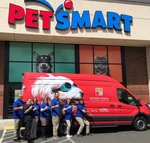


Big things are happening at the Humane Society for Southwest Washington (HSSW) as a $45,000 grant and donated labor and resources have led to a new animal transport vehicle and a revamped off-leash area for dogs to be dogs during their stay at the shelter.
In late June HSSW received a $45,000 grant from PetSmart Charities in order to purchase a “Rides to the Rescue” vehicle designed to transport dogs and cats from full shelters across the nation to the Clark County-based humane society.
HSSW accepted nearly 1,900 animals from other shelters last year. According to staff, the demand for dogs and cats in the Pacific Northwest exceeds the number of animals in shelters.
“Animal lovers in this area have supported adoption when choosing a new family member for many years,” they wrote when announcing the grant.
PetSmart Charities Regional Relationship Manager Jenny Aho said that her organization has partnered with HSSW for many years in their goal to find homes for animals.
“With the added resource of the PetSmart Charities-funded ‘Rides to the Rescue’ vehicle, they will be able to partner with other organizations that are just as passionate as they are about bringing the joys of pets to prospective pet parents in the Vancouver community,” Aho said.
“With our new ‘Rides to the Rescue’ vehicle, we have the ability to travel further and to more out-of-the-way locations to pick up animals that need a fresh start,” HSSW President Stacey Graham said.
HSSW Vice President and Director of Shelter Operations Lisa Feder said that the shelter had been looking at its own animal transport vehicle for a few years. Previous to receiving the grant and the vehicle, HSSW had to rent out cargo vans or borrow transport vehicles from other shelters in order to make the trips to where they could pick up the animals, she explained.
Feder gave some examples of how the Rides to the Rescue vehicle would be used. In some cases, a large transport coming from California will bring somewhere around the range of 150 dogs to a location like Eugene, Oregon. From there HSSW would head to that city or wherever the transport will stop to pick up some of the animals.
In other cases the vehicle could be used to head to a shelter a few hours away from HSSW to take in animals that location can’t handle, Feder added.
“It’s sort of a combination of some amount of local travel and some amount of going to Eugene or the Oregon border to meet people halfway,” Feder said.
“It makes it so much easier for us to do our jobs,” Feder said about the new vehicle. “It’s really nice to be able to say ‘yes’ (to receiving animals) without having to jump through hoops to figure out if we can even go and get a van to pick up animals.”
The new wheels weren’t the only improvement for HSSW recently. In late July volunteers descended on the shelter’s “Freedom Fence” off-leash areas to revamp the facilities, most notably including the laying of grass across what was formerly just dirt.
Feder said that the idea for the improvements started with one of HSSW’s staff, Tara Zimmerman, and some of the shelter’s volunteers brainstorming. She said the planning leading up to the work took about a year, finally undertaken the weekend of July 21.
Feder said the labor and resources were all donations which other than sod included some fencing rework to get the Freedom Fence facilities up to par with the rest of the improvements. Though she didn’t have a total estimate on hand, she said the fencing alone was worth roughly $15,000. About 25 volunteers including a group from Banfield Pet Hospital.
“It was a significant amount of labor,” Feder remarked.
With freshly-laid grass now covering the Freedom Fence areas, Feder said dogs staying at the shelter will be able to feel more at home in an environment more reminiscent of a backyard.
“Being in a shelter is really stressful for the dogs,” Feder said. “Everything that we can do to take a dog’s mind off of being in a kennel and the stress is a positive thing.”
The new improvements work toward that end, letting the shelter animals the opportunity to, as Feder said, “just be a dog.”
“It makes a big difference for them,” Feder said.